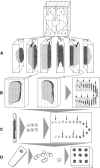An official research policy statement of the American Thoracic Society/European Respiratory Society: standards for quantitative assessment of lung structure
- PMID: 20130146
- PMCID: PMC5455840
- DOI: 10.1164/rccm.200809-1522ST
An official research policy statement of the American Thoracic Society/European Respiratory Society: standards for quantitative assessment of lung structure
Figures









References
-
- Lum H, Mitzner W. Effects of 10% formalin fixation on fixed lung volume and lung tissue shrink: a comparison of eleven laboratory species. Am Rev Respir Dis 1985;132:1078–1083. - PubMed
-
- Kendall MG, Moran PAP. Geometrical probability. London: Charles Griffin and Co., Ltd.; 1963. pp. 1–125.
-
- Miles RE, Davy PJ. Precise and general conditions for the validity of a comprehensive set of stereological fundamental formulae. J Microsc 1976;107:211–226.
-
- Miles RE, Serra J. Geometrical probability and biological structures: Buffon's 200th anniversary. Lecture notes in biomathematics [Vol 23]. New York: Springer-Verlag; 1978.
-
- Cruz-Orive LM. Stereology: historical notes and recent evolution. Acta Stereol 1987;6:43–56.
Publication types
MeSH terms
Substances
Grants and funding
LinkOut - more resources
Full Text Sources
Other Literature Sources
Medical

